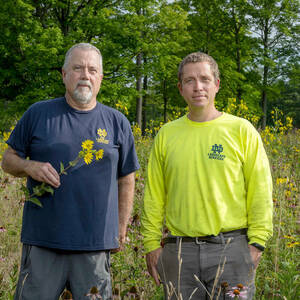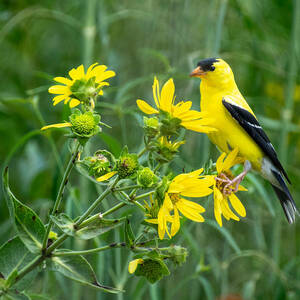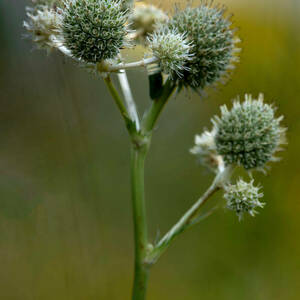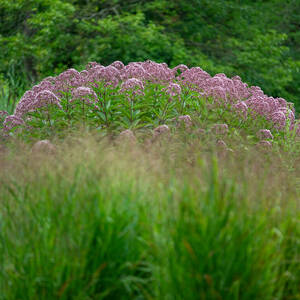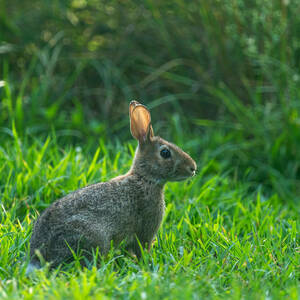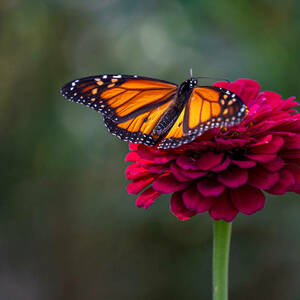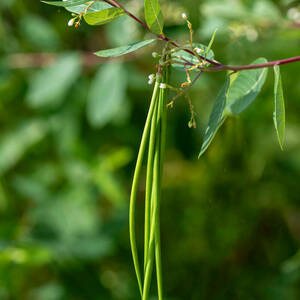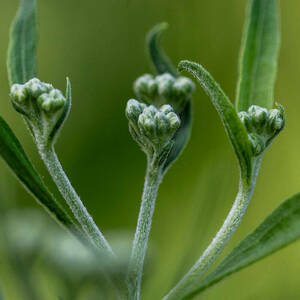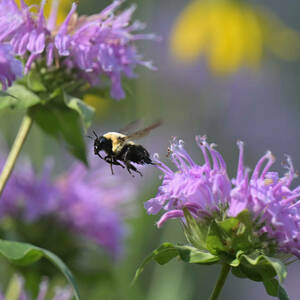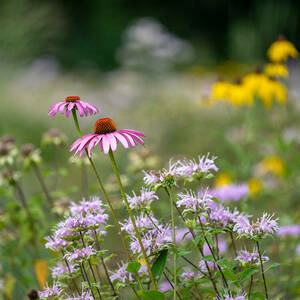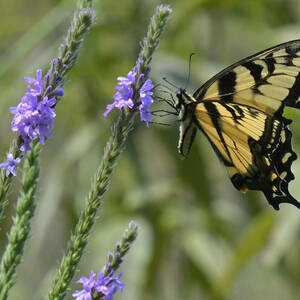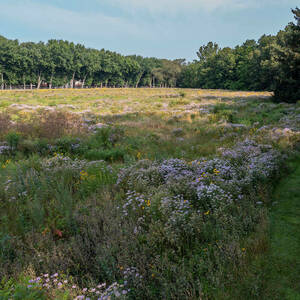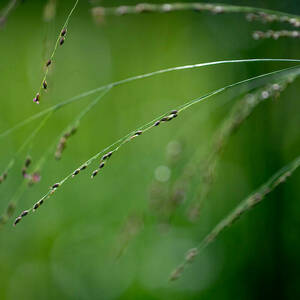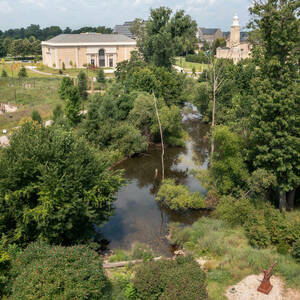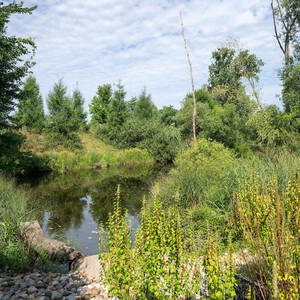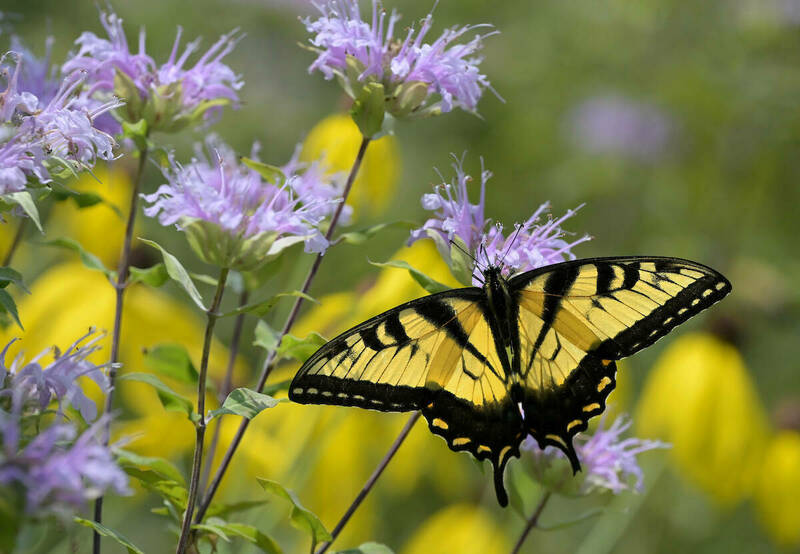 A tiger swallowtail butterfly in late July drinks nectar from bee balm blossoms in a field of native Indiana wildflowers on the west edge of the Notre Dame campus. Photography by Barbara Johnston
A tiger swallowtail butterfly in late July drinks nectar from bee balm blossoms in a field of native Indiana wildflowers on the west edge of the Notre Dame campus. Photography by Barbara Johnston
In early summer, the landscape beds that encircle Compton Family Ice Arena are a riot of colorful flowers and bird life. Common milkweed, gray-headed coneflower and purple hoary vervain rise above native grasses.
A variety of bees float from flower to flower, feeding on nectar and pollen. Nearby, a bird alights to feast on a blossom that has gone to seed. Spiderwort, pokeweed and wild geranium also are blooming.
Cars speed by on nearby Angela Boulevard, with many motorists likely unaware that an Indiana native prairie is in its full summer glory just off the roadway.
Notre Dame in recent years has created 21 acres of designated native pollinator areas, mostly in large plots along the edges of campus — surrounding the ice arena, in a field north of the WNDU-TV studio and in a triangle of land east of Notre Dame Federal Credit Union, for example. Some of the areas are seeded with a mix of nearly 30 native wildflower species.
In addition, the campus Landscape Services department is incorporating some native plants and flowers (and cultivars of natives) into smaller flower beds across campus, alongside more familiar annuals and perennials.
There’s a large yellow splash of black-eyed Susans in a flower bed east of the Hesburgh Library, stalks of bright-red cardinal flower in bloom near a residence hall, golden coreopsis in the planter at the foot of the Sacred Heart of Jesus statue on the Main Quad and purple coneflowers just outside Grace Hall.
Providing natural pollinator areas on campus makes good sense for the University and for the environment, says Beau Barnett, Notre Dame’s director of grounds and landscape.
“Protecting species and protecting our insect populations — not only butterflies, but pollinators in general — this is critical to agriculture,” he says. Orchards and agricultural growers rely on pollinators to produce the nation’s food, and pollinator habitats help farmers and benefit the region’s food production.
There are no plans to fully replace garden beds on campus with native plants. Students, employees and visitors can always expect to see tulips (native to central Asia) lining the walkway to the Grotto and near the Main Building in the springtime, Barnett says.
The University contracts with Walkerton, Indiana-based Stantec Native Plant Nursery to help plan and maintain the large native pollinator areas. The firm provides mixes of Indiana native seeds and Stantec workers visit the campus pollinator areas regularly in the warm months to pinpoint and remove invasive species before they spread.
Some of the most common invasive plants found and removed from Notre Dame's pollinator areas are Canada thistle, bush honeysuckle and purple loosestrife, says Jonathan Kingston, a Stantec senior associate and senior restoration ecologist.
Some of the campus prairie areas include varieties of milkweed, which is vital to the life cycle of monarch butterflies. Monarch numbers in North America have been declining for about two decades.
In addition to helping nature by promoting plants and flowers that help pollinators thrive, the natural prairie areas allow the University to integrate its sustainability goals into its land plan, Barnett says.
The native pollinator areas demand little manpower. They require no regular mowing, no watering, no fertilizer or chemicals, and they are seeded with perennials.
The faded plants are cut back to ground level in late fall or early spring. As the weather warms, the native prairies grow back on their own every year.
In late July, in the field near the credit union, there is an eye-catching bright yellow mass of black-eyed Susans and purple ironweed in full bloom. Spiky low-growing rattlesnake master is visible near the field’s edge, as well as orange butterfly weed.
At the south edge of campus, the nine-acre Charles B. Hayes Family Sculpture Park features an array of native grasses and other plantings designed by landscape architect Michael van Valkenburgh. An outdoor extension of Raclin Murphy Museum of Art, the park is designed to show off the major sculptural works on display.
Taking lead roles in the campus pollinators effort are Joe Rabbitt '04M.A., the campus floral crew supervisor, and groundskeeper John Zimmerman.
The first couple years, a field of newly seeded native flowers and plants can look a little sparse or unfinished. “After two to four years,” Rabbitt says, “that’s when it really takes off.”
When the first native plant fields were added to the campus landscape, “people were skeptical. It’s something new,” Zimmerman recalls. As individuals learn about the importance of native species for pollinators, they begin to understand, he says.
The campus pollinator fields have become outdoor classrooms for Ryan Sensenig, a professor of the practice in biological sciences. He teaches a Restoration Ecology course, and takes his students to visit and study those campus fields.
Sensenig and Max Scheel, a Ph.D. student in biological sciences, and others a few months ago created a small native plant and flower garden just east of Jordan Hall of Science, in an area formerly covered with lawn grass. It’s still in a fledgling state.
“I want my students to be able to walk out of the building and learn to identify some of these plants,” Sensenig says. “It’s kind of a living laboratory, where we can start to have specimens of native plants right next to the building.”
For many first-year students, learning about native plants and flowers of the Midwest is a brand-new experience. “Very few of them have ever walked in a tallgrass prairie or perhaps knew about the extent of tallgrass prairies in the Midwest and further west. A lot of the species are new to them,” he says. Students quickly become engrossed and understand why this is important, the professor adds.
Even if an undergraduate science major is studying for a career in medicine, he says, learning early about the indirect effects of climate change on human health and ecological health is a benefit.
For Sensenig, one of the biggest rewards of native pollinator prairies is simply raising awareness. “If we’re not surrounding ourselves in natural states," he says, "we’re going to lose awareness of what we once had — and therefore lose the ability to imagine what we could have.”
Along the east bank of St. Mary’s Lake is Our Lady’s Butterfly Garden, a plot of mostly native flowers first planted by members of the Class of 1976 during reunion weekend in 2016. A mix of plants — including coneflowers, Joe Pye weed and great blue lobelia — keep the garden blooming from spring until fall, attracting birds, butterflies, moths and bees.
Frank Fransioli ’77, a retired architect who proposed the garden, says he had the idea after learning that northern Indiana is on the migration routes for monarch butterflies. The eastern population of monarchs migrates to Mexico for the winter months.
Nearby, native plants and flowers are incorporated into the landscaping around the fountain in Our Lady of the Lake World Peace Plaza.
Bit by bit, Notre Dame is doing its part to nurture native plants for the benefit of birds, butterflies, bees and humans.
“We’re being good stewards of our campus resources and land,” Barnett says, “good stewards of our environment.”
Margaret Fosmoe is an associate editor of this magazine. Contact her at mfosmoe@nd.edu or @mfosmoe.
